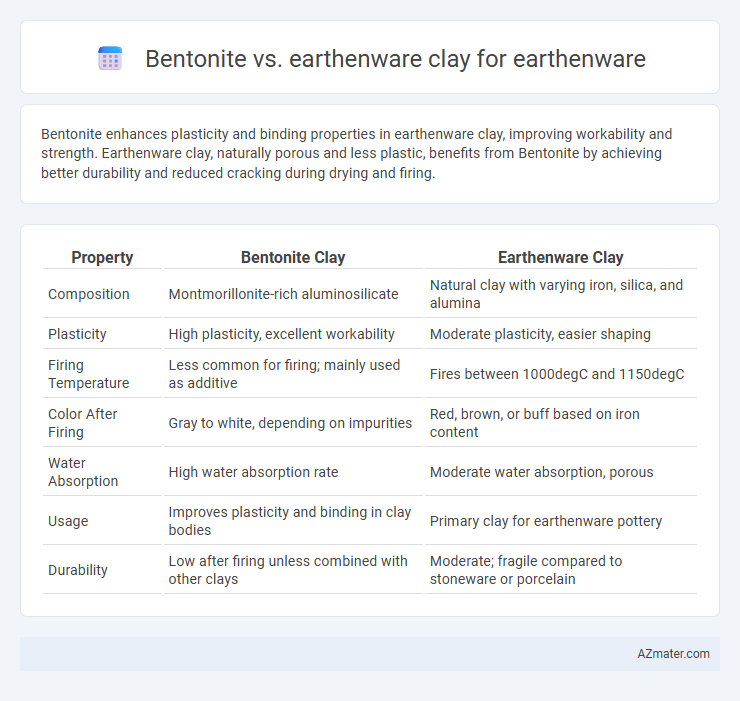Bentonite enhances plasticity and binding properties in earthenware clay, improving workability and strength. Earthenware clay, naturally porous and less plastic, benefits from Bentonite by achieving better durability and reduced cracking during drying and firing.
Table of Comparison
| Property | Bentonite Clay | Earthenware Clay |
|---|---|---|
| Composition | Montmorillonite-rich aluminosilicate | Natural clay with varying iron, silica, and alumina |
| Plasticity | High plasticity, excellent workability | Moderate plasticity, easier shaping |
| Firing Temperature | Less common for firing; mainly used as additive | Fires between 1000degC and 1150degC |
| Color After Firing | Gray to white, depending on impurities | Red, brown, or buff based on iron content |
| Water Absorption | High water absorption rate | Moderate water absorption, porous |
| Usage | Improves plasticity and binding in clay bodies | Primary clay for earthenware pottery |
| Durability | Low after firing unless combined with other clays | Moderate; fragile compared to stoneware or porcelain |
Introduction to Bentonite and Earthenware Clay
Bentonite is a highly absorbent clay composed primarily of montmorillonite, valued for its plasticity and ability to improve the workability and strength of earthenware clay bodies. Earthenware clay, characterized by its iron content and low firing temperature range (typically 1000-1150degC), is naturally porous and ideal for traditional pottery and decorative ceramics. Combining bentonite with earthenware clay enhances durability and texture, making it a preferred choice for potters seeking improved molding and reduced cracking during drying and firing.
Composition and Mineral Content Comparison
Bentonite is primarily composed of montmorillonite, a highly absorbent clay mineral rich in aluminum and magnesium silicates, providing superior plasticity and swelling properties. Earthenware clay, on the other hand, consists mainly of kaolinite, quartz, and mica, with a higher concentration of iron oxides that impart its characteristic reddish or brownish color. This mineral composition difference results in bentonite having higher cation exchange capacity and water retention compared to the more porous and less plastic earthenware clay.
Physical Properties: Texture and Plasticity
Bentonite exhibits a highly fine, smooth texture with exceptional plasticity, allowing it to retain water and maintain shape under stress, making it ideal for improving workability in earthenware clay. In contrast, earthenware clay has a coarser texture and moderate plasticity, which provides a balance between moldability and structural integrity. The higher plasticity of bentonite significantly enhances the flexibility and bonding properties of earthenware clay bodies, facilitating easier shaping and reducing cracking during drying and firing.
Water Absorption and Porosity Differences
Bentonite and earthenware clay exhibit significant differences in water absorption and porosity, with bentonite showing much higher water absorption rates due to its fine, plate-like particles that create a dense, plastic mass. Earthenware clay typically has higher porosity, allowing it to absorb more water, but its larger particle size compared to bentonite results in greater permeability and less plasticity. These differences influence firing behavior, with bentonite contributing to increased shrinkage and decreased porosity, while earthenware clay retains more moisture, affecting durability and glaze application.
Firing Temperature and Thermal Behavior
Bentonite, used as a plasticizer, enhances the plasticity of earthenware clay but has a higher firing temperature range of approximately 900-1100degC compared to earthenware clay's typical firing range of 1000-1150degC. Earthenware clay exhibits better thermal expansion and contraction behavior, allowing it to withstand moderate kiln temperatures without significant warping or cracking. Bentonite's fine particle size improves the workability of earthenware mixtures but slightly alters thermal properties by increasing shrinkage during firing.
Suitability for Pottery and Ceramics
Bentonite clay offers superior plasticity and binding properties, making it ideal for improving the workability and strength of earthenware clay in pottery and ceramics. Earthenware clay, composed primarily of natural minerals, is valued for its porosity and warm tones but generally requires blending with additives like bentonite to enhance durability and reduce cracking during firing. Choosing bentonite-enriched earthenware clay results in more consistent shaping, better moisture retention, and increased resistance to thermal shock in finished ceramic pieces.
Environmental Impact and Sustainability
Bentonite and earthenware clay differ significantly in environmental impact and sustainability, with bentonite being a natural absorbent clay primarily mined through strip mining, which can lead to habitat disruption and soil degradation. Earthenware clay, typically sourced locally and minimally processed, offers a more sustainable option due to lower extraction impact and better integration into natural cycles. Choosing earthenware clay supports reduced carbon footprint and promotes eco-friendly pottery practices compared to bentonite's more energy-intensive extraction and transportation processes.
Cost and Availability in the Market
Bentonite is generally more expensive than traditional earthenware clay due to its specialized adsorption properties and use in industrial applications. Earthenware clay is widely available and affordable, sourced directly from natural deposits, making it a cost-effective choice for artisans and potters. Market availability favors earthenware clay, which is stocked by most ceramic supply retailers, whereas bentonite is often sold in bulk for mass production or industrial use.
Pros and Cons: Bentonite vs Earthenware Clay
Bentonite clay offers superior plasticity and binding properties, making it ideal for enhancing the workability of earthenware clay, but it can cause shrinkage and cracking if used excessively. Earthenware clay naturally provides a smooth texture and is easier to fire at lower temperatures, but it lacks the adhesive strength of bentonite, which can affect the durability of the final product. Choosing between bentonite and earthenware clay depends on balancing the need for flexibility and strength against potential challenges in firing and finishing.
Choosing the Right Clay for Your Project
Selecting between bentonite and earthenware clay depends on the project's specific needs; bentonite offers superior plasticity and strength, making it ideal for slip formulations and improving workability. Earthenware clay provides traditional firing properties with natural iron content, suitable for pottery and decorative ceramics requiring warm, earthy tones. Understanding the composition and firing techniques of each clay type ensures optimal texture, durability, and aesthetic results in your ceramic creations.

Infographic: Bentonite vs Earthenware clay for Earthenware
 azmater.com
azmater.com